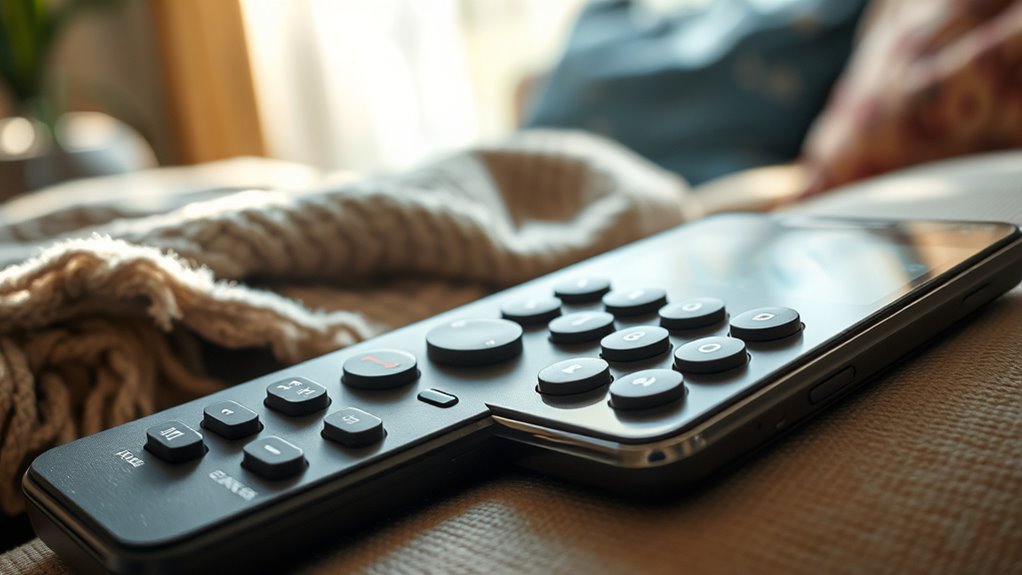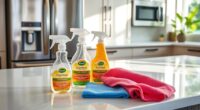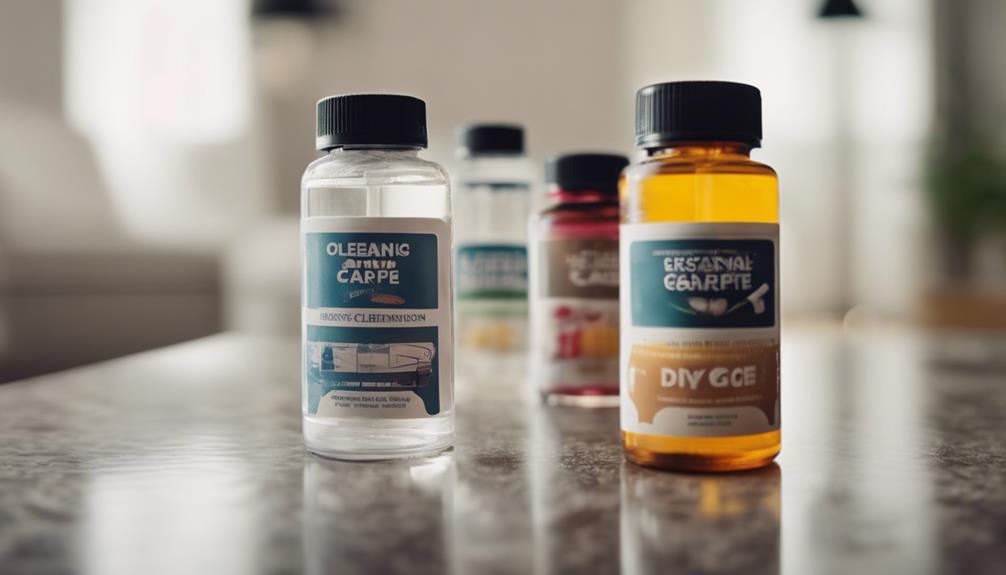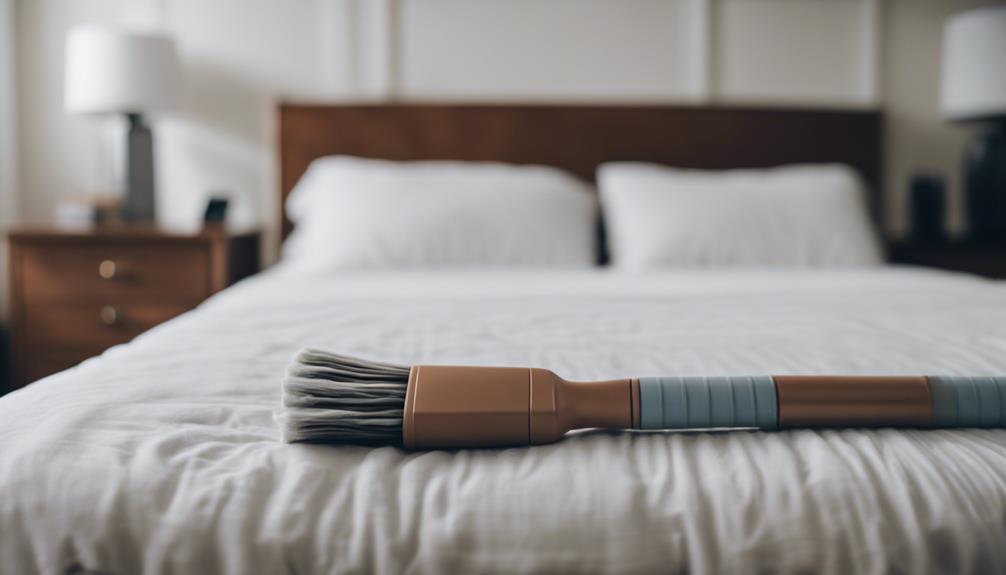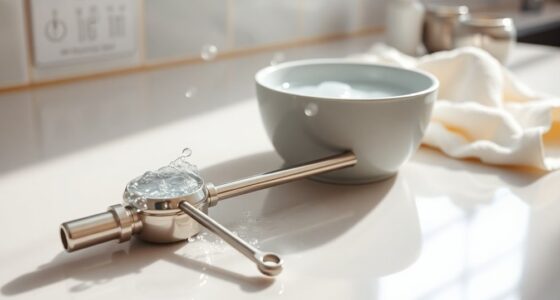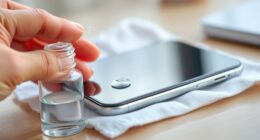Many common household surfaces hide germs you probably miss during cleaning, increasing your risk of illness. Frequently touched spots like remote controls, light switches, refrigerator handles, and shared electronics can harbor bacteria and viruses that survive long after they look clean. Your bedding, pillowcases, and personal items may also be teeming with germs if not washed regularly. To keep your home healthier, it is crucial to target these hidden hotspots—stay with us to discover more tips.
Key Takeaways
- Frequently touched objects like remote controls, light switches, and refrigerator handles often harbor hidden germs.
- Shared workspaces such as keyboards, mice, and phones can accumulate bacteria unnoticed.
- Bedding items like pillowcases and sheets can harbor germs if not washed regularly.
- Dorm room surfaces, including desks and door handles, are common germ hotspots.
- Tiny crevices in household appliances and electronics can trap bacteria and viruses.

Have you ever wondered where germs hide in your daily environment? It’s easy to overlook the tiny, hidden spots where bacteria and viruses can thrive. Many people focus on obvious surfaces like bathroom counters or kitchen sinks, but germs also lurk in places you might not suspect. For example, if you’re living in a dorm, dorm room germs are more common than you think. Shared spaces, such as desks, door handles, and even your bedding, can harbor bacteria that spread easily among roommates. Because dorms are tight quarters, germs spread rapidly, often without you realizing it. It’s important to clean frequently touched surfaces, especially your personal belongings and common areas, to reduce the risk of illness.
Similarly, in your office, you might not realize that your keyboard is a hotspot for bacteria. Office keyboard bacteria can accumulate quickly because many people use their keyboards throughout the day without cleaning them. Every keystroke transfers germs from your fingers to the keys, and these tiny crevices become breeding grounds for bacteria. If you share your workspace with others, the risk increases because germs can transfer from one person to another through shared equipment. Regularly disinfecting your keyboard with wipes or alcohol-based cleaners can substantially cut down on bacteria buildup. Don’t forget about your mouse and phone either—they often harbor just as many germs.
Germ hotspots aren’t always obvious. For instance, remote controls, light switches, and even the inside of your refrigerator handle are often overlooked. People tend to wash their hands but forget to sanitize these frequently touched objects, which can become breeding grounds for germs over time. Your pillowcases and bed sheets also harbor germs, especially if you don’t wash them regularly. These hidden spots can contribute to ongoing exposure to bacteria and viruses, increasing your chances of falling ill. Additionally, skin contact with contaminated surfaces can facilitate the transfer of germs to your body, highlighting the importance of proper hygiene.
Cleaning routines often focus on visible dirt, but bacteria are microscopic and can survive on surfaces long after they appear clean. Make it a habit to incorporate disinfecting wipes into your daily routine, paying special attention to areas that get touched often. Keeping your environment clean isn’t just about appearance; it’s an essential step in preventing illness. By recognizing these hidden germ hotspots and taking proactive measures, you’ll substantially reduce your risk of infection. Remember, staying healthy is about more than just washing your hands — it’s about controlling the germs lurking in those unexpected places in your home and workspace.
Frequently Asked Questions
How Often Should I Disinfect Hidden Germ Hotspots?
You should disinfect your home’s hidden germ hotspots at least once a week to maintain a healthy environment. Establishing a consistent hotspot cleaning schedule helps prevent the buildup of bacteria and viruses. For high-touch areas like doorknobs and light switches, consider more frequent disinfection, especially during flu season or illness outbreaks. Regular cleaning guarantees you minimize germ spread and keep your home safer for everyone.
Are Certain Household Items More Prone to Harboring Germs?
Some household items are more prone to harboring germs because they serve as common germ reservoirs. Items like sponges, dishcloths, and toothbrushes often trap bacteria if not regularly cleaned. To maintain household item hygiene, you should disinfect these frequently and replace them often. Being aware of these germ-prone items helps you reduce bacteria spread and keep your home healthier. Regular cleaning is essential for preventing germs from lingering on everyday objects.
Can Cleaning Products Effectively Eliminate Germs From These Hotspots?
Cleaning products like antibacterial sprays and natural disinfectants can effectively eliminate germs from hotspots. You should regularly use antibacterial sprays on high-touch areas to reduce bacteria, and natural disinfectants can be a safe alternative for other surfaces. Just guarantee you follow the instructions for each product, allowing enough contact time to kill germs thoroughly. Consistent cleaning with these products will help keep your home healthier and germ-free.
Do These Germ Hotspots Pose Health Risks to Children or Pets?
Germ hotspots can pose health risks to children and pets if not cleaned regularly. You might not realize how easily germs spread from surfaces they frequently touch or lick, increasing germ exposure risks. To guarantee children’s pet safety, clean these areas often with effective disinfectants. Staying vigilant helps reduce illness chances, keeping your loved ones safe from harmful bacteria lurking on overlooked surfaces.
What Are the Best Tools for Cleaning Hard-To-Reach Germ Areas?
To clean hard-to-reach germ areas effectively, you should use microfiber cloths and extendable brushes. Microfiber cloths trap and remove germs more efficiently, especially in tight spots, while extendable brushes help reach high or awkward places without straining. Together, these tools make cleaning easier and more thorough, ensuring you eliminate germs from those tricky spots and maintain a healthier home environment effortlessly.
Conclusion
Now that you know about these hidden germ hotspots, you can make a real difference in your home’s cleanliness. Did you know that the average smartphone harbors 10 times more germs than a toilet seat? By regularly disinfecting overlooked areas like remote controls and door handles, you reduce your risk of illness. Stay vigilant, clean smartly, and keep those sneaky germs at bay—your health depends on it!

